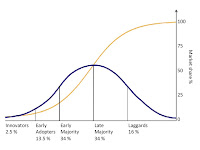I’m often asked if Meridian has an official Change
Management methodology. The short answer
is No.
I fear methodologies force-fit the same activities on every
situation. That does not work.
Instead we’ve distilled a set of principles that accelerate
the adoption of new methods, processes, and technologies.
1. People
Follow The Path of Least Resistance—So Your Desired Goal Had Better Be On It
People naturally seek the Path of Least Resistance--the
pathway that provides the least resistance to forward motion. A person taking the path of least resistance
seeks to minimize personal effort and/or confrontation.
It’s imperative to
credibly demonstrate how proposed change(s) are on the Path of Least Resistance—that is, how
a new technology is easier to use or offers more “reward” than current
approaches (“reward” in this context has many definitions, not just money).
Painting the picture
that a “new and improved” process or technology is easier to use is a bit of an
art. You can’t just say “this is better,
trust me”—people must come to the conclusion themselves. Hands-on exposure to the new methods or
technology is necessary. Success stories
that explain how the new method is easier and better help. Credible supporters who point out how the new
approach is on the right path are a requirement (see my next point).
Despite your efforts
a better approach can struggle to gain traction. In this case it’s proven effective to
directly ask “Why won’t you adopt our new approach? Why isn’t it better than our current methods? What will it take to get you to switch?” It takes some courage to ask these
questions—you might find that your next great idea is miles off the Path of
Least Resistance—but it’s better to know.
2. Tap
The Power of PEERS
 I am very interested
in the science of Diffusion—understanding how innovations spread through a
population. A core beliefs in Diffusion
science is The Principle of Homophily (Homophily = "Love
of the Same"). Homophily is the
tendency of individuals to associate and bond with people who are most
like them. Homophily plays a powerful
role in the adoption of new practices because we learn best from someone who is
like us.
I am very interested
in the science of Diffusion—understanding how innovations spread through a
population. A core beliefs in Diffusion
science is The Principle of Homophily (Homophily = "Love
of the Same"). Homophily is the
tendency of individuals to associate and bond with people who are most
like them. Homophily plays a powerful
role in the adoption of new practices because we learn best from someone who is
like us.
Homophily means it’s
imperative to find your experts amongst the population you are trying to
change. It’s important to ensure any and
all contractors who are engaged to help you change are most like your own
people. It’s better to actually grow
your own Change Leaders, selecting and supporting a sub-group of your people
who score high on familiarity to lead your change.
3. There’s PRIORITY & POWER, And They Aren’t
Owned By The Same People
 Adoption happens when it is clear that acceptance of the new
is a real organizational priority and equally that the person who has
immediate power over me allows or encourages adoption. Senior
executives foster adoption by lending their personal credibility to programs, deciding
which programs control the best resources, and determining the professional
gains accruing to contributors. But
“executive priority” alone will not ensure adoption.
Adoption happens when it is clear that acceptance of the new
is a real organizational priority and equally that the person who has
immediate power over me allows or encourages adoption. Senior
executives foster adoption by lending their personal credibility to programs, deciding
which programs control the best resources, and determining the professional
gains accruing to contributors. But
“executive priority” alone will not ensure adoption.
It’s rarely
acknowledged but true: Individual
contributors who have been asked to change how they work need the permission of
their immediate supervisor to make this change.
This ‘permission’ is subtle—I’m not going to ask, “Gee, can I use this
new accounting system?” but it will be abundantly clear to me whether use of
the new system is what the person who holds power over me wants or does not
want. Mid-management and supervisors
thus wield considerable power during times of change. Every successful change program must
understand and manage mid-level support for the program.
4. Never
Underestimate The Problems of the PAST
Expectations for current success are always based on
perceptions of past efforts and outcomes—even if those past efforts and
experiences are not directly applicable.
Think of your company’s history: How many projects were
regarded as disasters? How often do
people mention these disasters when a new project is
introduced?
In our work supporting clients striving for business change skepticism
about past efforts has material impact on support at least 80% of the time.
A major study we completed contrasting a sample of
successful and unsuccessful corporate initiatives showed that perceptions of
past support for projects was the second most important determinant of program
success (expectations for rewards was the most important determinant).
 Common sense strongly suggests a history of past failures colors
future plans, leading people to wonder, “So what’s different this time?”
Common sense strongly suggests a history of past failures colors
future plans, leading people to wonder, “So what’s different this time?”
And that’s precisely the point. You must understand how people view past
projects. And you must credibly explain
what’s different this time.
Many organizations want to bury the past. They regard it as ill-mannered to mention
past failures. They fear mentions of past
projects will somehow compromise people’s support, as if organizations lack
collective memory.
Not advised. It’s
important to allow people to express skepticism about past projects, within
bounds. It’s imperative to credibly and consistently show people how
this effort is different, and especially how this program’s results will differ.
5. Sustain “Offensive” Support
Support equals the people and processes that move people
from current practices to better processes.
Support usually happens after a problem occurs, rendering
the support reactive or defensive.
Effective support should be “Offensive,” committed and to
nipping problems early, often, and before they escalate.
“Offensive” support means telling people what is changing
and why, addressing “what this means to me,” allowing errors during adoption,
and providing mechanisms for eliminating errors over time. Support should start early in the program and
should sustain well past the formal “completion” or Go Live point.
Some examples of Offensive support include group and
individual Information Sessions, Self-Guided Change Discussions, and increasingly
online communities and forums. Change
Agents are critical—successful programs always deploy networks of people who are
trained and tasked with providing hands-on, grass-root level support and
leadership during times of change.
In Summary
Years of work supporting diverse change programs revealed
the Five Principles we use to accelerate adoption of new technologies and
methods.
So I encourage you to consider all five when plotting your next
organizational initiative.
But remember: While the principles are universal, the
actions derived from them are always situational. One size never fits all.




















